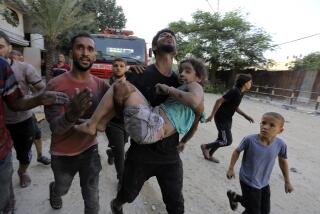Third World Infant Mortality
- Share via
I want to commend you on your excellent two-part series (Dec. 3-4) on the silent deaths of young children in Third World countries due to lack of a few cents of medicine and basic knowledge regarding hygiene. Our organization, American Service to India, is a nonprofit, charitable medical and educational foundation which is dedicated to helping women and children by sending medical aid to India and Bangladesh.
We are the major donors to Ramakrishna Mission, which is one of the foremost charitable organizations in India. They run several hospitals for poor and indigent people. We have a very good understanding of local priorities and a track record of effectively using the charitable donations. In fact, we send every dollar that is donated to the designated charity without any deductions for expenses such as salaries, overheads, etc., so 100% of the donated amount goes to the designated charity.
S.V. MURTHY
Vice President, Finance
American Service to India
Costa Mesa
* Thank you for your insightful and somewhat depressing series on child mortality. The graphics (Dec. 4) tell a great deal of the story: Americans give the least amount of money per capita to help others; and beer and cigarettes are more important than the lives of children in our world.
Changing the attitudes and actions of people, however, is problematic. I served for several years as the public relations director for World Vision, an agency working for child survival in nearly 100 nations. My staff and I confronted the same dilemma Peter Poore of Save the Children-United Kingdom mentions. Donors are fickle, or more appropriate, donors have been conditioned by aid agencies and journalists to give to life-and-death disasters--earthquakes, famines and mass movements of refugees. The important work of providing immunizations, health assistance, small business loans and the like is too boring to hold the attention of people.
Enlightened individuals must give consistently. They must also pressure Western governments to give more, not less, assistance. And they must demand account- ability from private and government agencies working in the Third World. Only then will the world’s children truly be safe from the needless misery they now confront.
KEN WATERS
Newbury Park
* I was dismayed by the comments of an anonymous AID staffer who characterized family planning as “peripherally related” to child survival endeavors, as reported in “Politics, World Crisis Sap ‘Child Survival’ Funds.” Such a statement suggests that family planning has, at best, little bearing on promoting infant and child health. On the contrary, by enabling women to space their pregnancies and to limit the number of children born to them, family planning is basic to an effective child survival strategy. Family planning and child survival efforts go hand in hand. Both are key priorities for AID and should not be viewed as competing with one another for dwindling resources; nor should their accounts be diverted to other initiatives for which they were not intended.
JEANNIE I. ROSOFF, President
Alan Guttmacher Institute
Washington
More to Read
Sign up for Essential California
The most important California stories and recommendations in your inbox every morning.
You may occasionally receive promotional content from the Los Angeles Times.













